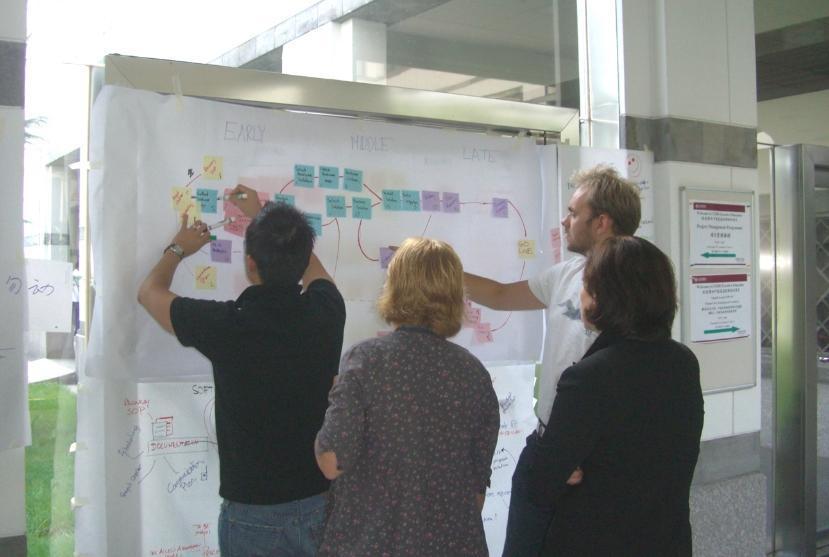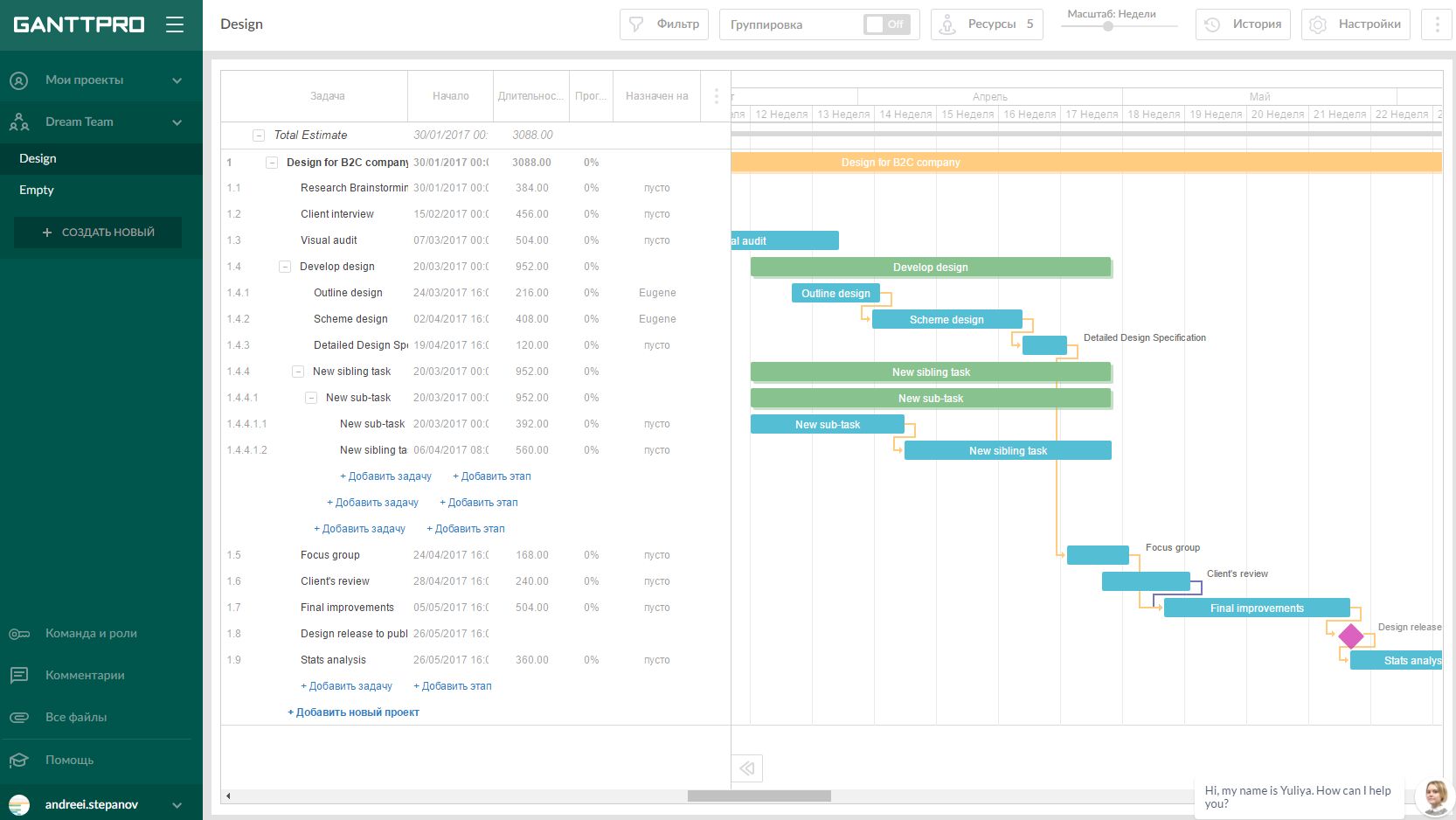Benefits of the Hierarchical Work Structure (WBS) for IT Project Managers
Managers dealing with complex IT projects will confirm that dividing tasks into smaller and more manageable parts makes the workflow a lot easier. In this article I will talk about a process that will help to structure each stage of the project and take into account all the tasks. This is a hierarchical structure of the work of WBS (Work Breakdown Structure) .

If you remember how to use the Agile project management methodology , determine the critical path and set SMART goals, then it's time to move to a new level of competency in project management.
The hierarchical structure of WBS , or the decomposition structure, is a scheme where the tasks of the project reflect their relationship to each other and to the project as a whole. The term was first used in the United States in 1993.
WBS is based on a graphical nature that helps project managers predict outcomes based on different scenarios. A process is often described as a branch structure that spans all stages of a project in an organized manner. WBS can also be represented as a tabular list of tasks and elements in terms of a breakdown of the work of Gantt charts .
Managers use a decomposition structure to structure and divide projects into easily manageable components. They, in turn, are divided until they are assigned to a specific specialist in the team.

We will analyze WBS using the example of planning an event. Suppose there is a task - to organize and oversee a corporate picnic or team building. Using WBS, tasks can be described and divided as follows:
Planning : research, budget planning, plan approval and approval, coordination issues.
Meals : menus, purchases, cooking, service.
Venue and activities : tables and seats, dishes, decoration and equipment, branding.
Participants / guests : invitations, guest list, special occasions.
Staff : drivers, cook, waiters, cleaners.
Headliner : invitation, logistic issue, scenario / playlist approval.

According to the hierarchical structure, it is necessary to go through several stages (components) in order to optimize and simplify the management process:
These components may have different names depending on the company.
5 steps to design a simple WBS structure
To achieve the objectives of the project, you must follow a specific implementation plan for WBS.
Start with a design concept and statement of key points at the top of the hierarchy. Define all the necessary tasks on which the results will depend. Ideally, the efforts of the whole team should be involved in the planning and conceptualization process. Nevertheless, each specialist should be responsible for the implementation of a specific task.
So, the steps:
1. Approve and write down the project.
It can be just a sentence or paragraph that describes the concept and functions of the project after the final stage. This stage of WBS is the foundation of any project and is usually developed by the whole team.
2. Highlight all the key steps
After the first stage is completed, you can proceed to the next.
You may need to divide the task into many stages depending on the nature of your project. Typically, this depends on requirements, budget options and time frames.

3. Define the final results.
Formulate for yourself all the points that must be completed during each stage. All of them must have final results. You must achieve them completely before proceeding to the next step. Each end result should also have its own description, goals and functions.
4. Divide the end results into manageable tasks
After creating the list of end results, add another hierarchy level to calculate the parts. The tasks of the project should be performed in sections. Any team member or small team will be able to easily manage them.
5. Distribute tasks
Assigning responsibility for each part of the work is the last stage of the hierarchy. A specific specialist will be responsible for a specific task. He / she will participate in each stage of the work, which will lead to quality results.
The video shows an easy way to create WBS.
As a rule, managers use the structure in the development of commercial, housing and construction projects. With it, it is easier for investors and customers to understand what is happening in the development of a project.

Software developers also first approve concepts and create requirements based on them. This gives WBS the features of an ideal development tool.
If we try to classify the commands that can use the WBS tools, we get the following list:
The WBS framework has become popular and widely used in software development due to its obvious advantages. Project managers boldly apply it. And here's why:
1. Strengthening communication in the project team
It doesn’t matter if your IT project has an internal or external focus. The hierarchical structure of the work includes communication acts at every step.
2. A field for creativity
It seems like a stereotype, but people think that software development is only analytical work. No, there is still room for the development of creative abilities. In determining the concept of the project, team members can use WBS and offer creative ideas for the development of the project.
3. Focus on ultimate goals
WBS helps keep the whole team focused and focused on the ultimate goal. This minimizes the chance of doing unnecessary work.
4. Detailing
Every detail is carefully considered, therefore, nothing is lost in the project.
5. Anticipation of problems
When the project is ready, unforeseen problems may arise. The hierarchical structure of the work helps to reduce their number, since all the details are taken into account before execution.
6. Brainstorming
Managers use the brainstorming framework to find useful ideas and solutions. With its help, they are easy to collect, and then delete them from unnecessary.
7. Planning Considerations
Using WBS, it is easy to determine which of the planned tasks are behind schedule.
8. Risk Management
If you use WBS, you reduce risks and manage them from the very beginning. This helps to allocate all resources: cash, time and labor.
9. Distribution of tasks
When you structure your project, it becomes easier to assign tasks to specific people.
10. Flexibility for various teams. The
hierarchical structure of work is used in various fields. It does not matter how many people are on the team: WBS will always support the project implementation process. It can also be an excellent tool for attracting customers, as it shows the processes from the inside and helps them better understand.
To display the hierarchical structure of the work, the practice of applying Gantt charts is widespread. They clearly reflect the entire structure, and in a very convenient form. Gantt charts are used in many project management programs and services, such as GanttPRO , MS Project , Wrike , etc.
Here's what it looks like with the GanttPRO example.

The Gantt chart allows you to expand the functionality of the hierarchical structure of work. So, thanks to her, the start and end dates of the task are clearly visible, its full extent, who performs it, what is the progress of implementation, the relationship between tasks. In addition, milestones can be identified - important events that affect the project, as well as the critical path.
Gantt chart online is also suitable forproject team management . Under each task, you can leave comments, attach files, share the schedule itself, export it to popular formats, view the change history - team work is really convenient. However, as well as tracking other processes related to project management.
The hierarchical structure of work is a common and convenient way to plan IT and any other projects. And if you display it with a Gantt chart, then in this form it greatly simplifies the process of not only planning, but also management. With it you can:

If you remember how to use the Agile project management methodology , determine the critical path and set SMART goals, then it's time to move to a new level of competency in project management.
What is the hierarchical structure of WBS jobs?
The hierarchical structure of WBS , or the decomposition structure, is a scheme where the tasks of the project reflect their relationship to each other and to the project as a whole. The term was first used in the United States in 1993.
WBS is based on a graphical nature that helps project managers predict outcomes based on different scenarios. A process is often described as a branch structure that spans all stages of a project in an organized manner. WBS can also be represented as a tabular list of tasks and elements in terms of a breakdown of the work of Gantt charts .
Managers use a decomposition structure to structure and divide projects into easily manageable components. They, in turn, are divided until they are assigned to a specific specialist in the team.

Why you should use WBS:
- Helps to organize projects correctly;
- Assists in describing the content of the project for interested parties;
- Helps to distribute responsibilities;
- Shows the main stages of the project and all aspects of control;
- Allows you to correctly assess the costs, risks and time of work.
We will analyze WBS using the example of planning an event. Suppose there is a task - to organize and oversee a corporate picnic or team building. Using WBS, tasks can be described and divided as follows:
Planning : research, budget planning, plan approval and approval, coordination issues.
Meals : menus, purchases, cooking, service.
Venue and activities : tables and seats, dishes, decoration and equipment, branding.
Participants / guests : invitations, guest list, special occasions.
Staff : drivers, cook, waiters, cleaners.
Headliner : invitation, logistic issue, scenario / playlist approval.

WBS Components
According to the hierarchical structure, it is necessary to go through several stages (components) in order to optimize and simplify the management process:
- Approval of the project concept;
- Stages that depend on the size of the project;
- Tasks with intermediate results.
These components may have different names depending on the company.
5 steps to design a simple WBS structure
To achieve the objectives of the project, you must follow a specific implementation plan for WBS.
Start with a design concept and statement of key points at the top of the hierarchy. Define all the necessary tasks on which the results will depend. Ideally, the efforts of the whole team should be involved in the planning and conceptualization process. Nevertheless, each specialist should be responsible for the implementation of a specific task.
So, the steps:
1. Approve and write down the project.
It can be just a sentence or paragraph that describes the concept and functions of the project after the final stage. This stage of WBS is the foundation of any project and is usually developed by the whole team.
2. Highlight all the key steps
After the first stage is completed, you can proceed to the next.
You may need to divide the task into many stages depending on the nature of your project. Typically, this depends on requirements, budget options and time frames.

3. Define the final results.
Formulate for yourself all the points that must be completed during each stage. All of them must have final results. You must achieve them completely before proceeding to the next step. Each end result should also have its own description, goals and functions.
4. Divide the end results into manageable tasks
After creating the list of end results, add another hierarchy level to calculate the parts. The tasks of the project should be performed in sections. Any team member or small team will be able to easily manage them.
5. Distribute tasks
Assigning responsibility for each part of the work is the last stage of the hierarchy. A specific specialist will be responsible for a specific task. He / she will participate in each stage of the work, which will lead to quality results.
The video shows an easy way to create WBS.
Who can use WBS?
As a rule, managers use the structure in the development of commercial, housing and construction projects. With it, it is easier for investors and customers to understand what is happening in the development of a project.

Software developers also first approve concepts and create requirements based on them. This gives WBS the features of an ideal development tool.
If we try to classify the commands that can use the WBS tools, we get the following list:
- Creative groups . Creative people value structure for being able to brainstorm together.
- Technical teams . Technically oriented specialists choose WBS for the analytical perspective of the scope of work and their progression.
- Teams that work directly with clients . The hierarchical structure of the work is good for professionals developing software for customers, as it meets their needs. It also helps to increase customer confidence in your team.
- Internal team projects .
- Remote commands .
WBS Structure Benefits for IT Project Managers
The WBS framework has become popular and widely used in software development due to its obvious advantages. Project managers boldly apply it. And here's why:
1. Strengthening communication in the project team
It doesn’t matter if your IT project has an internal or external focus. The hierarchical structure of the work includes communication acts at every step.
2. A field for creativity
It seems like a stereotype, but people think that software development is only analytical work. No, there is still room for the development of creative abilities. In determining the concept of the project, team members can use WBS and offer creative ideas for the development of the project.
3. Focus on ultimate goals
WBS helps keep the whole team focused and focused on the ultimate goal. This minimizes the chance of doing unnecessary work.
4. Detailing
Every detail is carefully considered, therefore, nothing is lost in the project.
5. Anticipation of problems
When the project is ready, unforeseen problems may arise. The hierarchical structure of the work helps to reduce their number, since all the details are taken into account before execution.
6. Brainstorming
Managers use the brainstorming framework to find useful ideas and solutions. With its help, they are easy to collect, and then delete them from unnecessary.
7. Planning Considerations
Using WBS, it is easy to determine which of the planned tasks are behind schedule.
8. Risk Management
If you use WBS, you reduce risks and manage them from the very beginning. This helps to allocate all resources: cash, time and labor.
9. Distribution of tasks
When you structure your project, it becomes easier to assign tasks to specific people.
10. Flexibility for various teams. The
hierarchical structure of work is used in various fields. It does not matter how many people are on the team: WBS will always support the project implementation process. It can also be an excellent tool for attracting customers, as it shows the processes from the inside and helps them better understand.
WBS + Gantt chart = improved planning process
To display the hierarchical structure of the work, the practice of applying Gantt charts is widespread. They clearly reflect the entire structure, and in a very convenient form. Gantt charts are used in many project management programs and services, such as GanttPRO , MS Project , Wrike , etc.
Here's what it looks like with the GanttPRO example.

The Gantt chart allows you to expand the functionality of the hierarchical structure of work. So, thanks to her, the start and end dates of the task are clearly visible, its full extent, who performs it, what is the progress of implementation, the relationship between tasks. In addition, milestones can be identified - important events that affect the project, as well as the critical path.
Gantt chart online is also suitable forproject team management . Under each task, you can leave comments, attach files, share the schedule itself, export it to popular formats, view the change history - team work is really convenient. However, as well as tracking other processes related to project management.
To summarize
The hierarchical structure of work is a common and convenient way to plan IT and any other projects. And if you display it with a Gantt chart, then in this form it greatly simplifies the process of not only planning, but also management. With it you can:
- Set tasks and distribute them among the participants;
- Set deadlines for tasks, their duration, progress;
- Establish dependencies between tasks;
- Visualize important key events - milestones;
- Identify the critical path;
- Interact with the team.
